The editor continues his assessment of the biggest stars in Hindi filmdom
Nutan: She is an all-time great. Has many outstanding performances to her credit.
 She could do a Bandini or a Sujata and then feel extremely comfortable in a frothy Tere Ghar Ke Saamne or a Dilli Ka Thug.
She could do a Bandini or a Sujata and then feel extremely comfortable in a frothy Tere Ghar Ke Saamne or a Dilli Ka Thug.
Rajesh Khanna:
 He was the first superstar. He broke the stranglehold of the Big Three. Dilip Kumar, Raj Kapoor and Dev Anand in the late 1960s to take stardom to a new high. Women wrote his name in blood. Men swore by his style. No actor before him or after him has whipped up the kind of frenzy he did among his fans in the early 1970s.
He was the first superstar. He broke the stranglehold of the Big Three. Dilip Kumar, Raj Kapoor and Dev Anand in the late 1960s to take stardom to a new high. Women wrote his name in blood. Men swore by his style. No actor before him or after him has whipped up the kind of frenzy he did among his fans in the early 1970s.
 Dharmendra: He was the first he-man on the Indian screen to be acknowledged as an actor. He achieved the impossible feat of combining virility with vulnerability. Essentially a director's actor, as Hrishikesh Mukherjee once described him, Dharmendra has to his credit films ranging from Phool Aur Pathar, Ghulami, Pratigya, Satyakam and Sholay to Chupke Chupke, which underscore his versatility. He was the only actor to withstand Rajesh Khanna's phenomenal sweep in the early 1970s.
Dharmendra: He was the first he-man on the Indian screen to be acknowledged as an actor. He achieved the impossible feat of combining virility with vulnerability. Essentially a director's actor, as Hrishikesh Mukherjee once described him, Dharmendra has to his credit films ranging from Phool Aur Pathar, Ghulami, Pratigya, Satyakam and Sholay to Chupke Chupke, which underscore his versatility. He was the only actor to withstand Rajesh Khanna's phenomenal sweep in the early 1970s.
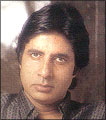 Amitabh Bachchan: He is is the biggest star Hindi screen has ever seen. Though he didn't whip up the kind of frenzy Rajesh Khanna did at his peak, his popularity reached a phenomenal high in the 12 years that followed Zanjeer (1973). During that phase only five of his 60-odd films failed at the box office. A supremely-gifted actor, he invariably rose above the films he acted in and the roles he played. With an uncanny ability to connect both with the masses and the classes, he became a cult figure in the 1970s and the 1980s.
Amitabh Bachchan: He is is the biggest star Hindi screen has ever seen. Though he didn't whip up the kind of frenzy Rajesh Khanna did at his peak, his popularity reached a phenomenal high in the 12 years that followed Zanjeer (1973). During that phase only five of his 60-odd films failed at the box office. A supremely-gifted actor, he invariably rose above the films he acted in and the roles he played. With an uncanny ability to connect both with the masses and the classes, he became a cult figure in the 1970s and the 1980s.

Naseeruddin Shah: He is one of a kind. An explorer among actors, his body of work stands out for class and consistency. He seems to have an insatiable desire to excel himself.
 Jaya Bhaduri: Clumsy, small and fragile-framed, Jaya Bhaduri broke the mould of the Hindi film heroine and paved the way for simple-looking but talented actresses like Shabana, Smita, Zarina and Rameshwari. She was the first to cut into Rajesh Khanna's phenomenal pull at the box-office in the early 1970s. She was at the peak of glory when she decided to marry Amitabh Bachchan and quit films.
Jaya Bhaduri: Clumsy, small and fragile-framed, Jaya Bhaduri broke the mould of the Hindi film heroine and paved the way for simple-looking but talented actresses like Shabana, Smita, Zarina and Rameshwari. She was the first to cut into Rajesh Khanna's phenomenal pull at the box-office in the early 1970s. She was at the peak of glory when she decided to marry Amitabh Bachchan and quit films.
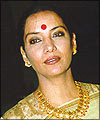 Shabana Azmi: For years now, good acting has been synonymous with Shabana Azmi. A rare combination of talent and intelligence, Shabana has played an unimaginable range of roles, some of them no heroine would dare attempt. Like Naseer, she has a body of work which is astounding, and which has fetched her five national and six international awards.
Shabana Azmi: For years now, good acting has been synonymous with Shabana Azmi. A rare combination of talent and intelligence, Shabana has played an unimaginable range of roles, some of them no heroine would dare attempt. Like Naseer, she has a body of work which is astounding, and which has fetched her five national and six international awards.
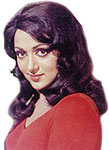 Hema Malini: Her reign at the top, which lasted nearly two decades from the early 1970s to the late 1980s, was unrivalled. Like Bachchan's, her box office record is phenomenal. In the 1970s she became the country's leading sex symbol, strangely without shedding her inhibitions or clothes. She was the heroine most big-time heroes went to for support when the chips were down. Like Rajesh Khanna in Prem Nagar and Dev Anand in Johny Mera Naam. Her pairing with Dharmendra was sensational. Their box office record includes 16 consecutive hits!
Hema Malini: Her reign at the top, which lasted nearly two decades from the early 1970s to the late 1980s, was unrivalled. Like Bachchan's, her box office record is phenomenal. In the 1970s she became the country's leading sex symbol, strangely without shedding her inhibitions or clothes. She was the heroine most big-time heroes went to for support when the chips were down. Like Rajesh Khanna in Prem Nagar and Dev Anand in Johny Mera Naam. Her pairing with Dharmendra was sensational. Their box office record includes 16 consecutive hits!
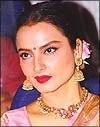 Rekha: She is a cosmetic wonder. The longest surviving glamour star, who has been around for three decades. From a plum, ordinary-looking girl, she transformed herself into a much-envied sex-symbol. She was the uncrowned No 1 in the mid-1980s before Sridevi took over. She has been a role model for three generations of young actresses.
Rekha: She is a cosmetic wonder. The longest surviving glamour star, who has been around for three decades. From a plum, ordinary-looking girl, she transformed herself into a much-envied sex-symbol. She was the uncrowned No 1 in the mid-1980s before Sridevi took over. She has been a role model for three generations of young actresses.
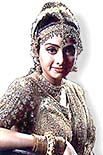
Sridevi: A combination of Geeta Bali, Vyjayantimala and Mumtaz, Sridevi towered over her contemporaries as a versatile actress. But for the language barrier, she could have been the greatest ever. She was the biggest star of the 1990s, though she wasn't acknowledged as such because of her poor media relations.
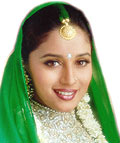 Madhuri Dixit: Madhuri's rise to fame may be attributed to her looks -- she's often compared with Madhubala -- and her incredible flair for filmi dance. More than her performances Madhuri wowed the 1990s generation with some sizzling dance numbers -- like Ek do teen, Choli ke peeche kya hai and Dhak dhak karne laga -- which considerably influenced the pattern of film-making.
Madhuri Dixit: Madhuri's rise to fame may be attributed to her looks -- she's often compared with Madhubala -- and her incredible flair for filmi dance. More than her performances Madhuri wowed the 1990s generation with some sizzling dance numbers -- like Ek do teen, Choli ke peeche kya hai and Dhak dhak karne laga -- which considerably influenced the pattern of film-making.
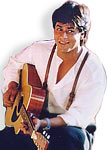 Shah Rukh Khan: He's the star of the 1990s. He has had one major blockbuster to his credit every year since he made his debut in 1991. His hits include Baazigar, Dilwale Dulhaniya Le Jayenge, Dil To Pagal Hai, Karan Arjun and Kuch Kuch Hota Hai. His style and demeanour seemed to catch the fancy of the 1990s generation. A gifted actor, he has gone for variety in the choice of roles, and shown a lot of courage in opting to play negative roles as in Baazigar and Darr.
Shah Rukh Khan: He's the star of the 1990s. He has had one major blockbuster to his credit every year since he made his debut in 1991. His hits include Baazigar, Dilwale Dulhaniya Le Jayenge, Dil To Pagal Hai, Karan Arjun and Kuch Kuch Hota Hai. His style and demeanour seemed to catch the fancy of the 1990s generation. A gifted actor, he has gone for variety in the choice of roles, and shown a lot of courage in opting to play negative roles as in Baazigar and Darr.
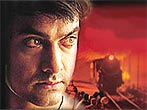 Aamir Khan: A supreme individualist, Aamir burst on the scene when the industry was on the look out for a new formula to bridge the gap left by Amitabh Bachchan's temporary exile. With him the genre of teenage romance got a major boost (Qayamat Se Qayamat Tak) and he became an instant teenage idol. A cerebral actor, Aamir now works within the parameters he has set for himself without pandering to boxoffice norms.
Aamir Khan: A supreme individualist, Aamir burst on the scene when the industry was on the look out for a new formula to bridge the gap left by Amitabh Bachchan's temporary exile. With him the genre of teenage romance got a major boost (Qayamat Se Qayamat Tak) and he became an instant teenage idol. A cerebral actor, Aamir now works within the parameters he has set for himself without pandering to boxoffice norms.
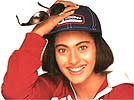 Kajol: A worthy successor to her aunt Nutan, Kajol is the real female star of the 1990s. The heart-throb of the 'in' generation. Spontaneous yet meticulously correct, her style, in a way, is an extension of Geeta Bali's. It has the same timeless quality to it.
Kajol: A worthy successor to her aunt Nutan, Kajol is the real female star of the 1990s. The heart-throb of the 'in' generation. Spontaneous yet meticulously correct, her style, in a way, is an extension of Geeta Bali's. It has the same timeless quality to it.
'Four generations of actors have been inspired by Dilip Kumar'
Tell us what you think of this list
